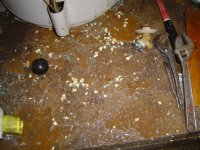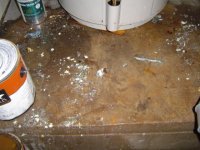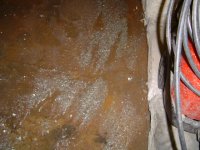tmajor
Platinum Member
- Joined
- Oct 9, 2007
- Messages
- 704
- Location
- NE PA
- Tractor
- 2010 MF 1529, Woods ZTR MZ1952, National Mower sickle bar circa 1963
This is a topic, which I wasn't totally unaware of, but didn't give it too
much consideration.
My 1998, 40 gal. LP hot water heater, seemed a bit strange a year or so
ago. It seemed like the water was cooler and the burner didn't seem to
respond as quickly. I thought the burner control was getting marginal. I
may have flushed the tank, I don't recall. It's been usable in the
meantime.
About a week ago, i noticed the hot water coming into the clothes
washer, was slower than normal. I took off the hoses and found the hot
hose was filled (nearly plugged) with white shards of ???. After some
Googling, it seemed like it could be disintegration the "dip-tube" in
the hot water heater. The "dip-tube" is a plastic tube, which goes from
the cold water inlet to the tank, down toward the bottom (internally),
so the cold water does not mix with the hot, right at the top of the
tank.
Because the tank is 19 years old, I felt it wouldn't hurt to replace it,
at this point. However, the new tanks are a couple of inches taller,
which presented problems with venting in my current configuration.
So, I flushed the tank, numerous times, all the while getting large
shards of plastic, rust and "goo". .... some, I had to pull out with a
wire or pliers. Finally, I removed the cold water line, to find that the
dip-tube was totally gone, except for about 1" at the top. To get the
most of the old deteriorated dip-tube out, I removed the boiler cock at
the bottom. After installing the new dip-tube and re-connection of the
water supply, I flushed it more thoroughly, until all signs of plastic
and goo seemed to be cleared.
In the pictures, you'll see the plastic, one piece which is about a 6"
piece of melted plastic. Also, in the one picture, you see my foot
prints in the goo (about 1/4" deep), which had drained. (I finally, just allowed the water
to run out on the floor and to the outside drain.)
So, if you see a change in water temperatures, etc., the first thing
would be to open the drain cock and flush the bottom ... should probably
be done once a year. Keep in mind, that the dip-tube could be be going
bad. Electric heaters could loose the dip-tube, but it probably wouldn't melt on the bottom of the tank.
The water temperature is more consistent, now. In the meantime, I can try to figure out, how to install a taller tank, when needed.
A melted dip-tube can't be healthy!



much consideration.
My 1998, 40 gal. LP hot water heater, seemed a bit strange a year or so
ago. It seemed like the water was cooler and the burner didn't seem to
respond as quickly. I thought the burner control was getting marginal. I
may have flushed the tank, I don't recall. It's been usable in the
meantime.
About a week ago, i noticed the hot water coming into the clothes
washer, was slower than normal. I took off the hoses and found the hot
hose was filled (nearly plugged) with white shards of ???. After some
Googling, it seemed like it could be disintegration the "dip-tube" in
the hot water heater. The "dip-tube" is a plastic tube, which goes from
the cold water inlet to the tank, down toward the bottom (internally),
so the cold water does not mix with the hot, right at the top of the
tank.
Because the tank is 19 years old, I felt it wouldn't hurt to replace it,
at this point. However, the new tanks are a couple of inches taller,
which presented problems with venting in my current configuration.
So, I flushed the tank, numerous times, all the while getting large
shards of plastic, rust and "goo". .... some, I had to pull out with a
wire or pliers. Finally, I removed the cold water line, to find that the
dip-tube was totally gone, except for about 1" at the top. To get the
most of the old deteriorated dip-tube out, I removed the boiler cock at
the bottom. After installing the new dip-tube and re-connection of the
water supply, I flushed it more thoroughly, until all signs of plastic
and goo seemed to be cleared.
In the pictures, you'll see the plastic, one piece which is about a 6"
piece of melted plastic. Also, in the one picture, you see my foot
prints in the goo (about 1/4" deep), which had drained. (I finally, just allowed the water
to run out on the floor and to the outside drain.)
So, if you see a change in water temperatures, etc., the first thing
would be to open the drain cock and flush the bottom ... should probably
be done once a year. Keep in mind, that the dip-tube could be be going
bad. Electric heaters could loose the dip-tube, but it probably wouldn't melt on the bottom of the tank.
The water temperature is more consistent, now. In the meantime, I can try to figure out, how to install a taller tank, when needed.
A melted dip-tube can't be healthy!


